Level of surfing
Competent
Quality of surf
Very Good
Call code
1684
Net code
as
Area
199
Coastline
116 km
Climate
Tropical Maritime – Monsoon Season (Nov-Apr) Dry Season (May to October). South East trade winds prevelant
Hazards
Very Isolated, Severe Storms
Best Months
May - August
Population
57663
Currency
United States Dollar (USD)
Time Zone
KILO (UTC+11)
Special Requirements
Strict Religious Observance
introduction
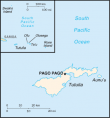
Map of American Samoa (US Territory)
American Samoa is an unincorporated territory of the United States in the South Pacific. . Though legally separate from Samoa, the two lands share near identical culture and demographics. The main island of Tutuila is also home to the capital Pago Pago.
There is good surf on the southern shores of Tutuila which are well supported by the prevelant SW to SE swell and wind patterns. Offshore island and atolls which are part of the country have not been adequately explored at this stage to quantify their surf potential. Like most surf within the South Pacific, reef breaks are the norm. Hence, surfing at American Samoa requires a degree of competency and comfort in surfing in the vicinity of shallow razor sharp coral reefs.
history

Tu'i Man'a Elisala - the last of the Tu'i Man'a chiefs c.1899
The area now known as American Samoa was settled early in the great waves of Polynesian exploration, perhaps as early as 1000BC. European contact did not occur until the 18th century when French Explorers were greeted with a frosty reception that led to battle casualties on either side.
Missionaries eventually followed in the 1830’s and led to the complete christianisation of the islands. The United States and Germany took control over the area in the late 1800’s with the United States settling for the eastern areas and Germany claiming what is now Independent Samoa.
A US base was established on the Island in WW II. These close ties to the United States have continued to the present day.
surfing
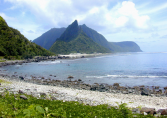
Eric Guinther: Mt Ofu, viewed from the village of Silli on Olosega; 2005
Surfing in American Samoa is really for the experienced rider only. All of the main breaks are on sharp living coral. An awareness of tidal movement is very important as many of the spots dry at low tides. Predominantly, surf tends to be at its best on the mid tide heading towards the high. Breaks can be fine moving into the low tide also– just be sure you keep an eye on how low it’s getting.
There still isn’t a lot of tourism here and few of the locals surf, so the only competition you are likely to face in the water are from expat Americans. Standard rules apply when integrating with local surfers. The native Samoans are typically very strict Catholics and usually cover themselves even when swimming. It’s probably not a bad idea to be wearing a rash vest here anyway as a UV filter but probably not the place to go out surfing in your latest fluoro pink G-string for a laugh while your girl friend sunbakes topless on the beach.
The swell window for the main island is open from the South west to the South East. The numerous reefs and atolls to the South West can attenuate swells however, especially the Fiji island group. The challenge is often matching up the tide with the right swell and squeezing that in between the trade winds which generally give you a window of a few hours in the morning. We don’t want to make it sound too hard however as there is good surf here, especially between the June to August period when the larger low pressure systems thread their way up between Australia and New Zealand into the South Pacific. If you can get one to thread a little further to the east and miss Fiji you should be in for a real treat.
travel
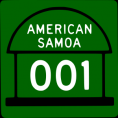
Highway Route No.1 - American Samoa
Flying is the most common method of arrival in American Samoa. This route is serviced by Air New Zealand, Hawaiian Airlines and some of the smaller local carriers. Generally you will fly to Apia (Independent Samoa) and then take a shorter flight to the capital Pago Pago. There are several flights per day.
Local buses are fun but chaotic. Car hire is limited and should be pre booked though one would expect this will change as tourism continues to increase. Hiring a scooter is probably the best way to get around the island and check the spots. The locals here are very friendly and if they see you walking will generally stop to offer you a lift. This is pretty common place on the island with cars being American open top utes. Just bang on the roof to get them to stop. You don’t need to give the driver money but I always did – word gets around and suddenly you will never be short of a ride.
Few locals surf so you should bring a map with you with the spots pre listed. Don’t expect them to know the names of spots such as Sliding Rock, but if you can point it out you should be fine. If you are flying to some of the other islands in the locality via one of the smaller airlines it is worth double checking…triple checking your bookings.
A few local carriers have filled the void since Samoan Airlines went bankrupt in 2003 and they are still learning the craft of effective bookings. My spin is that they have adopted the American technique of overbooking every aircraft by 15%. This is fine if you are in LAX of JFK airport and only have to wait 30mins for the next flight – when the next flight is tomorrow or the day after depending on where you are going this can be very frustrating.
weather
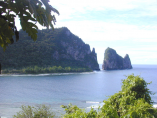
Eric Guinther: Vatia Bay towards Pola Tai; 2005
Climate is typical of a Tropical Maritime environment with little variation in temperature throughout the year. The best periods for surf are during the June / July period when the onshore trade winds are at their weakest and the chance of SW bomb swells at their highest. There is generally no more than 3 degrees separating temperature variations all year with minimums of 22 and maximums of 31 being the norm all year. Most rain falls in the summer (Dec-Feb)
where to stay

Eric Guinther: Charlie the Tuna - Starkist cannery in Atu'u; 2005
There is a mixture of accommodation available on the island. The lodges around the 50USD a day mark are pretty good and generally include all meals. Anything around 20USD is going to be shocking…I mean really shocking. If you are really on a tight budget then I’d try to stay with some locals, at least you have a better chance of your gear not being stolen from your room.
The Rainmaker Hotel is the top of the range and will set you back a few hundred dollars a night. This hotel has the best swimming beach on the island however with pristine Australian white sand having been imported and overlayed over the volcanic gravel and coral.
what to pack
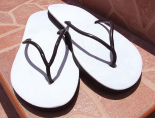
Flashdance: A pair of very simple Moroccan flip flops called "Cabjuks"; 25 May 2007
Take a very good sunscreen with high level of protection. It is
absolutely essential, as well as sunnies, hats, long sleeved shirts and
long skirts for ladies to cover legs. Don’t underestimate the strength
of the sun; your skin won’t forgive you. Just in case you still ignore
our advice, take a lot of Aloe Vera. Repellent might be useful as well.
Medicines – as usual.
You may also need a pair of waterproof boots and a good backpack if you
plan to explore the islands. Depending on the season tropical rains can
be quite often, so it’s a good idea to take something waterproof if you
plan to go outside. Another option would be just to stay at you place
and have a nap – the whole atmosphere is very laidback.
Though many resorts have snorkelling gear, better take your own,
especially if you plan to do a bit of travelling to different islands.
Take a few light and casual things, nothing fashionable – you won’t
need it there. Camera, adaptor, good books to read and music. Oh, yeah,
booties, helmet and top will be useful on the reef break, as it can get
quite shallow.






